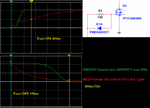carpenter
Full Member level 6
I need realise high current Full H bridge and search driver for Mosfet in bridge
- Voltage 80V
- MOSFET in driver 8x IPT012N08N5 2pcs parelel on every position
this MOSFET is 80V 300A Rdson 1,0mOhm , Input capacitance 13nF (26nF on two pcs)
drive signal ideal 3.3V logic from MCU
What I need from the bridge
1. Swing output with frequency 1-1000Hz and adjustable "duty cycle"
2. Set low side On and mege any PWM sequence on hifg side switch
3. Realise one shot from 1,s to 1s
Which controller would you recommend?
I find hip4081a, but not ideal and do not know how to charge 26nF., not 3.3V compatible
- Voltage 80V
- MOSFET in driver 8x IPT012N08N5 2pcs parelel on every position
this MOSFET is 80V 300A Rdson 1,0mOhm , Input capacitance 13nF (26nF on two pcs)
drive signal ideal 3.3V logic from MCU
What I need from the bridge
1. Swing output with frequency 1-1000Hz and adjustable "duty cycle"
2. Set low side On and mege any PWM sequence on hifg side switch
3. Realise one shot from 1,s to 1s
Which controller would you recommend?
I find hip4081a, but not ideal and do not know how to charge 26nF., not 3.3V compatible

